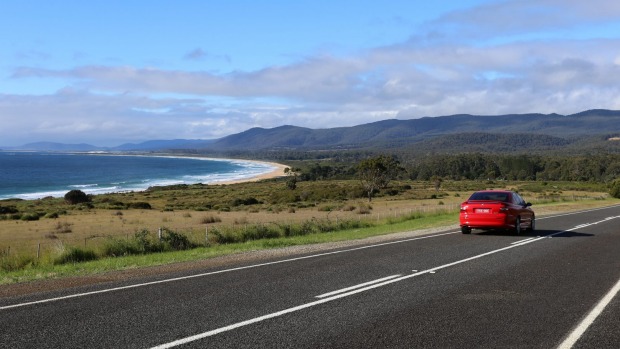
These are exciting times for the Apple Isle. According to the latest Tasmanian Visitor Survey, 16 per cent more tourists visited in 2014 and their total expenditure soared by nearly 20 per cent, to $1billion.
I wouldn't be surprised if most of those tourist dollars were spent on Tasmanian food, either in Hobart's emergent restaurant scene or on delectable produce from providores, markets and cellar doors.
As I travel the east coast from Hobart to the Bay of Fires north, on an eight-day road trip meeting food producers, restaurateurs and accommodation providers, I find them all quietly optimistic. Some, like sixth-generation Tasmanian Mary McNeill, from Gourmania food tours in Hobart, attribute the changing paradigm to the MONA (Museum of Old and New Art) effect.
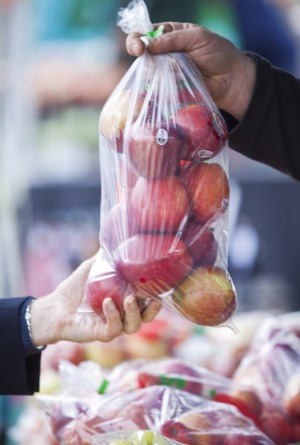
"MONA's success has sent out an important message about Tasmania: that anything is possible here if you put your mind to it," says McNeill.
Opened in 2011 by professional Taswegian gambler and philanthropist David Walsh, the subterranean hotchpotch of ancient coinage, Roman mosaics and neo-conceptual works, such as Wim Delvoye's Cloaca Professional – essentially a stinky poo-making machine – is so unusual that it alone provides justification enough to fly south. I'd gladly revisit next weekend to gaze again at Sidney Nolan's Snake arabesque, 44-metres broad, 5.6-metres high and comprising 1620 individual images.
However, while MONA has its own classy fine dining restaurant, The Source, and is built on the site of the Moorilla winery, it doesn't account for the increasingly glowing reputation of Tasmanian food and wine. Nor is former Fairfax restaurant critic Matthew Evans, who shifted to Tassie to "breed pigs and grow brussels sprouts", entirely responsible for making us all go ga-ga over its gourmet produce. The state was producing top-class food and wine long before television cameras drew wider attention to it.
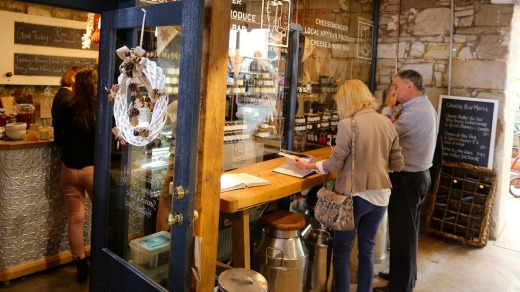
My visit is, shockingly, only my second in 20 years, an oversight partly explained by my predilection for warmer climes. Visiting in summer, the east coast produces everything from warm sunshine to persistent rain, to snow and sleet – you read that right – on cloud-shrouded Mount Wellington, behind Hobart.
But what I realise during this road trip is that you don't visit Tasmania for the weather. You go for its newly galvanised capital, to feast and slurp wine like a monarch, and to savour the peaty taste of the world's finest single malt whisky at Sullivans Cove distillery.
You hurry south to see beaches the colour of vanilla gelato, nudged by a teal Tasman Sea and bookended by granite outcrops encrusted with red lichen. To see grassy pastures, trout-filled rivers and lakes, hills indomitable enough to call mountains and terrier-like Tassie devils. And, you now also visit to marvel at the MONA art museum, displaying (language warning)… 140 life-sized sculptures of women's "c--ts".
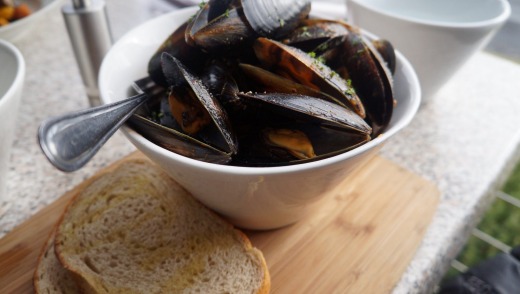
I begin in Hobart, taking up residence at the Avalon City Retreat, a glass-fronted penthouse craned on to a central Hobart office block, with views across the harbour and Derwent River estuary. It's an arty, neatly designed eyrie from which to locate the purveyors of fine food and drink I'll be swooping down upon.
Dinner on my first night is at new South American-themed restaurant, Frank , in Salamanca Square.
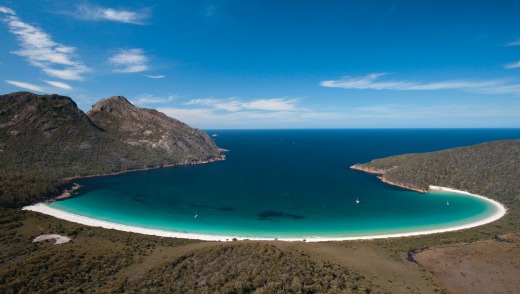
The following morning I take a flight of fancy, journeying the short distance to MONA on a seaplane. Even in buffeting drizzle, I note how Hobart gathers around its many bays and the Derwent River like a mini-Sydney. I stay at the museum all day, interrupting my consumption of art with a tasting at the on-site cellar door and two impeccable courses – spanner crab salad followed by blue-eyed cod with clam sauce and chorizo oil – at The Source .
The next morning, before beginning my drive north, I join a Hobart gourmet adventure with New York trained-chef Mary McNeill, beginning at Salamanca Place. Of all those I meet, McNeill is Tasmanian gastronomy's foremost apostle, leading me around 10 venues, including the Wursthaus Kitchen deli, just above Salamanca, and running a commentary laced with regional fervour.
"We're just 2 per cent of the population," she tells me, "but produce 10 per cent of Australia's vegies, 25 per cent of its potatoes and nearly all its quality salmon.
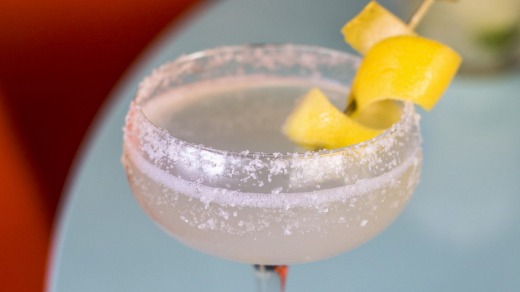
"Tasmania's become much more of an island since we've become interested in the provenance of food," she says, after tastings at Tassal Salmon Shop and Bruny Island cheese company, in Salamanca.
Hobart is necessarily the fulcrum for the island's food, so I'm keen to gauge, on my journey up the east coast, if the excitement extends beyond the capital. But then that's a silly question when your next stop is Saffire Freycinet resort, voted the world's top boutique hotel in 2014, and its restaurant is the domain of executive chef Hugh Whitehouse.
Everything Whitehouse and his team deliver during my stay is as impeccable as the glinting views over Great Oyster Bay from Saffire's Palate restaurant. Over four meals, each dish appears like a lustrous artwork, from a first entree of seared scallops in green pea puree followed by Muscovy duck with duck and pistachio sausage, to my final baked-egg breakfast. The food isn't merely pretty, but locally and seasonally sourced, and packed with flavour and texture.
It's as well that there are treks in Freycinet National Park to offset my immoderation. Even on a rain-soaked day, walking along Wineglass Bay, surely Australia's most aesthetically pleasing beach, adds to impressions of being somewhere exceptional.
Venturing further north from Freycinet to the Bay of Fires, head-turning curves of blond sand appear at nearly every turn, many naked of development and smoothed by chiffon-like ripples in the Tasman Sea. For the next two nights I stay behind one such delicious, empty beach, at the rustic Arthouse, in Binalong Bay, near the tip of Tassie's east coast.
Overlooking the bay, I find Moresco , a new restaurant, delivering excellent Mediterranean-style fare, their Tasmanian seafood broth just the ticket on a cold summer night.
This bayside village is also where former Brisbane chef Roz MacAllan, inspired by Rick Stein's success at Padstow in Cornwall, has set up Kiss a Fish Cookery School.
"People don't buy much fish because they don't know what to do with it," says MacAllan, who offers intensive day-long courses. "The food culture is strong in Tasmania and I'm a big exponent of 'ocean to plate', so this seemed the perfect place to do this."
Another day and another drive through Tasmanian countryside, this time into the hinterland behind St Helens, provides more stand-out produce to sample. At Pyengana Dairy Company, cheesemaker Jon Healey keeps winning awards for cheddar produced to his grandfather's recipe. The milking shed, complete with robotic massage function, suggests that pampered cows make for prized cheese.
My epicurean east coast odyssey is nearly over and I'm yet to have a poor meal anywhere. The good run continues at Mohr & Smith restaurant in St Helens, with artful simplicity at work in my dinner of hot smoked salmon cake with green onion salsa, and fettucini marinara stuffed with fish, scallops and mussels.
The next day I make it back to Hobart for brunch at the much-recommended Pigeon Hole cafe , where the eggs en cocotte are another hit. I brave the packed Salamanca markets before adjourning to Lark Distillery for an evening of music and whisky tastings.
I end my trip at Hobart's Sunday morning Farm Gate market. The love-child of co-ordinator Madi Peattie, a former croupier at Wrest Point Casino, where MONA founder David Walsh discovered his gambling talent, this celebration of Tassie food is guaranteed to make you salivate. I'm still eating, rolling "Lady Hester" sourdough doughnuts around my mouth, and meandering through sumptuous scenery, well into my final two hours in Tasmania.
Only this morning the backdrop is formed by hillocks of oyster and shitake mushrooms, from Cygnet in the Huon Valley, and ridges of Asian greens and bulbous purple garlic from Campania, in the Coal River region. The produce, like the stallholders selling it, is generous, perky and diverse, and suggests that the Apple Isle deserves a new sobriquet.
Chorizo Isle, perhaps? Or, Extra Virgin Cold Pressed Island?
No, Isle of Plenty ought to do.
discovertasmania.com
Virgin Australia flies to Hobart from Melbourne 33 times weekly, fares from $119, and ex Sydney 14 times, fares starting at $135.
Avalon City Retreat in Hobart costs from $900 a night; see avalonretreats.com.au/city.
Saffire Freycinet has all-inclusive rates from $1950 a room/per night; see saffire-freycinet.com.au.
Arthouse Bay of Fires, Binalong Bay, costs $500 a night, two nights minimum; see arthousebayoffires.com.au.
Kiss a Fish Cookery School has full-day "Ocean to Plate" classes at Roz MacAllan's Bay of Fires beach house; cost $350; see kissafishcookeryschool.com.au.
Hobart Scenic Flights has flights from $125 each; see tasmanianairadventures.com.au.
MONA opens Wednesday-Monday 10-6pm; admission $25; see mona.net.au.
Gourmania food tours has three-hour city tours costing $120, including tastings; see gourmaniafoodtours.com.au.
Pyengana Dairy Company, St Columba Falls Road, is 20 minutes' drive inland from St Helens; open 7 days, 10-4pm in winter; see pyenganadairy.com.au.
The Farm Gate Market is in Bathurst Street, Hobart, open 8.30am-1pm Sundays; see farmgatemarket.com.au.